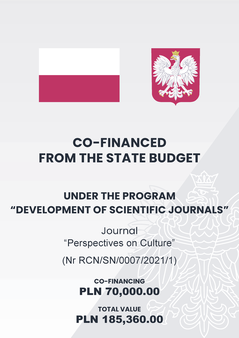“Inevitable Variability of the World” or Disguise in the Turkish Literature of the Tanzimat Period
Abstract
The focus of the article revolves around the examination of the role of attire within the early works of the Tanzimat period. Significant focus was directed towards the motif of women enrobing male attire and vice versa. Illustrative instances of this motif are discerned in two seminal works authored by prominent writers of the era: Namık Kemal’s drama Vatan yahut Silistre and Şemsettin Sami’s novel Taaşşuk-ı Talat ve Fitnat. The introductory segment delineates the epoch of reform, spanning the latter half of the 19th century, followed by an exposition of the literary landscape of the period, accentuating the pivotal role of garb within the narrative framework. Subsequently, succinct biographies are presented, followed by a discourse on themes associated with disguise. In Taaşşuk-ı Talat ve Fitnat, the eponymous character, Talat, assumes female garb, imperiling his reputation, to gain access to the abode of his beloved. Conversely, in Vatan yahut Silistre, Zekiye dons masculine attire to pursue her beloved who has departed for war, set against the backdrop of the Crimean War. Both works serve as a plea for greater freedom of association between individuals bound by affection.
References
Atalay, E. (2021). 19. Yüzyıl Osmanlı İstanbul’unda Kadın Kıyafetinin Evrimi. ETÜT, sayı 2, 131-161. DOI: 10.52003/etut.2021.12.
Barthes, R. (2005). System mody. Tłum. M. Falski. Kraków: Wydawnictwo Uniwersytetu Jagiellońskiego.
Borkowska, G. (2007). Życie codzienne jako kategoria literacka i badawcza (rekonesans). W: G. Borkowska i A. Mazur (red.), Codzienność w literaturze XIX (i XX) wieku. Od Adalberta Stiftera do współczesności. Opole: Wydawnictwo Uniwersytetu Opolskiego, 27-38.
Kanter, F. (2021). Tanzimat’tan Cumhuriyet’e Türk Hikâyesi (1860-1923). W: Ö. Emiroğlu (ed.), Türk Edebiyatı Tarihi, c.1, 819-844.
Morawski, S. (1976). Estetyka a semiotyka. Pamiętnik Literacki, tom 67, nr 3, 359-402.
Namık Kemal. (2022). Vatan yahut Silistre. İstanbul: Türkiye İş Bankası Kültür Yayınları.
Pogonowska, E. (2018). Semiotyka ubioru mieszkańców czerwonej Rosji na podstawie polskich relacji podróżniczych z lat 30. XX wieku. Napis, XXIV, 155-178. DOI: 10.18318/napis.2018.1.10.
Şemsettin Sami. (2011). Taaşşuk-ı Talat ve Fitnat. İstanbul: Akvaryum Yayınevi.
Tan, M. (2016). Başlangıcından Cumhuriyete Romanımızda Yanlış Batılılaşan Tipin Kılık Kıyafeti Üzerinde Bazı Dikkatler. W: Uluslararası Edebiyat ve Toplum Sempozyumu, Bartın: BÜ Yayınları, s. 445-458.
Yılmaz, D. (1990). Roman Kavramı ve Türk Romanının Doğuşu. Ankara: Kültür Bakanlığı Yayınları.
Copyright (c) 2024 Ignatianum University in Cracow

This work is licensed under a Creative Commons Attribution 4.0 International License.
Autor, zgłaszając swój artykuł, wyraża zgodę na korzystanie przez Wydawnictwo Uniwersystet Ignatianum z utworu na następujących polach eksploatacji:
- utrwalania utworu w formie papierowej, a także na nośniku cyfrowym lub magnetycznym;
- zwielokrotnienia utworu dowolną techniką, bez ograniczenia ilości wydań i liczby egzemplarzy;
- rozpowszechniania utworu i jego zwielokrotnionych egzemplarzy na jakimkolwiek nośniku, w tym wprowadzenia do obrotu, sprzedaży, użyczenia, najmu;
- wprowadzenia utworu do pamięci komputera;
- rozpowszechniania utworu w sieciach informatycznych, w tym w sieci Internet;
- publicznego wykonania, wystawienia, wyświetlenia, odtworzenia oraz nadawania i reemitowania, a także publicznego udostępniania utworu w taki sposób, aby każdy mógł mieć do niego dostęp w miejscu i czasie przez siebie wybranym.
Wydawca zobowiązuje się szanować osobiste prawa autorskie do utworu.






